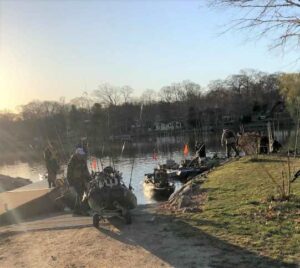Hydrilla Invades Rhode Island’s Indian Lake
Hydrilla verticillata. They’re not exactly household words but Hydrilla is a plant, an aggressive, invasive aquatic plant which has just been identified in South Kingstown’s Indian Lake.
That is terrible news for waters, anglers, boaters and aquatic ecosystems. Some watchful folks along the lake noticed what they thought was an uncommon plant and, thankfully, called RIDEM. The State has taken notice. Friends of The Saugatucket has rallied their troops. As Hydrilla invades Indian Lake, URI’s Watershed Watch is organizing. Now, it’s up to anglers and boaters to recognize it, report it and help keep Hydrilla out of other waters.
“Hydrilla can grow while others cannot,” said Bill McCusker of the Friends of the Saugatucket group. Hydrilla is a survivalist marvel and a freshwater nightmare. With fair conditions, it can grow an inch per day as it moves for the surface. It survives, even thrives, in low quality, low nutrient waters, even with low sunlight. That aggressive growth often results in thick matting on pond floors, which crowds other plants. Then those mats can reach the surface where they expand exponentially and can grow to be several feet thick. That mess shades out native plants, reduces food and shelter sources for small fish, reduces dissolved oxygen levels, takes over feeding areas for ducks and geese, slows drainage and when it decays, strips waters of oxygen, which kills fish and can, in some cases, reduce sizes of surviving fish as they struggle with less food. There is some evidence that is came to the states from Asia’s aquarium trade since it grows just fine in a small tank of dingy water and bored spotted fish in clown suits. Lucky us.
Hydrilla will grow from just a fragment so when a boater hauls out and doesn’t inspect or wash, there can be parts and pieces on the hull. According to the New York Division of Lands and Forests, “In addition to producing seed, hydrilla has green overwintering buds called turions and tubers that grow at the end of the roots and store energy.” Then that boat gets launched into a different pond and an invasion of a Federal Noxious Weed begins anew. According to the City of Norwalk, Ct., Hydrilla can also grow in slightly brackish waters, which should be horrifying to coastal communities. We are a state blessed with hundreds of ponds, lakes and streams so there’s no room for assigning blame to carriers. Recreational and competitive anglers crisscross the Ocean State to fish and paddle different waters. The best solution is to be aware of the plant, know about other invasives, like Chinese water chestnut, Eurasian milfoil, and fan wort, prevent its movement and clean your boat.
We are all stewards of our Earth
“Hydrilla may hamper the river herring; if it jumps the dam and enters Fresh Meadow Brook,” Mr. McCusker said, referring to Indian Lake, where volunteers have worked tirelessly for years to help alewives and blueback herring reach their natal waters.
Best management practices are easy. When you haul your boat out, clean all plant parts and pieces from the hull, trailer, wheels and even paddles. If you have water in the bilge, drain it away from the pond so that you don’t increase an invasive’s presence. Rinse everything with fresh water and let it dry before relaunching. Since this invasion likely originated with someone dumping their aquarium in a pond to release fish, please do not release any type of plant, fish, shellfish or even bait fish into a water body.

Then it’s easy passage through Fresh Meadow Brook
“Come to the training, learn to identify Hydrilla,” said Mr. McCusker. We are all stakeholders when it comes to preventing an invasive species and now that Hydrilla has been identified in the state, several groups are working collaboratively to educate people and limit its expansion. Good folks, like Jane Bessette of the Indian River Fire District, are establishing a Hydrilla Response Coalition and want you to join them at the Indian Lake boat ramp at the end of Indian Trail South in South Kingstown on Monday, October 9. The goal is to share information on the plant, help you properly identify it, know who to call if you see it and learn more about how to prevent Hydrilla’s movement. Plans are still coming together, like all these motivated people and there might even be some boats involved. If you have questions, you should reach out to Elizabeth Herron, Program Director for the URI Watershed Watch program at 401.874.4552 or email her at emh@uri.edu. For more information on invasive aquatics, check out www.protectyourwaters.net.

So many people use Indian Lake
Sometimes we reflect on the way things used to be, that “good old days” stuff but right here, just now, reading “Hydrilla Invades Indian Lake”, we have a chance to stop something we are aware of, that will severely damage our shared waters, diminish our fisheries and, considering that we should respect Nature over our own recreational pursuits, potentially destroy another healthy body of water. Contemplating the seriousness of Hydrilla verticillata, Mr. McCusker said, “Containing what’s in Indian Lake is the most important thing right now.” Amen and See you on October 9.










A bummer indeed. Especially if it was from an aquarium. Certainly state agencies have been preaching the clean and dry gospel to boaters for years now but I’m not sure the aquarium fish pet trade groups have done the same with regard to invasive plant species. Not sure how or when the exotic pet trade industry got so powerful but it’s time for government regulators got more serious in this regard.
Agreed all around. The bright spot here is that is was identified quite quickly so there is some hope to eradicate it but that might be a stretch.